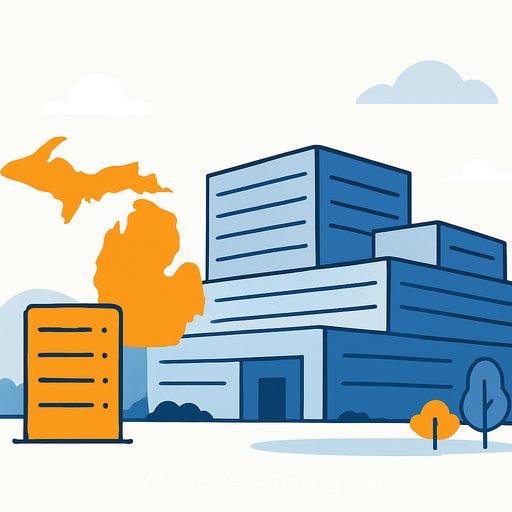Massive AI Data Center Coming to Saline Township: What Builders and Developers Need to Know
A 250-acre data center campus is set to rise in Washtenaw County's Saline Township. OpenAI and Oracle, alongside a Related Companies affiliate (Related Digital), plan to break ground early next year as part of their "Stargate" AI infrastructure buildout.
The site is designed for more than 1 gigawatt of computing capacity - a draw Wall Street analysts have compared to a nuclear reactor. Three single-story buildings, roughly 550,000 square feet each, anchor the plan, with construction expected to start in early 2026.
Michigan leaders are calling this the largest economic project in state history. The developer says the project will deliver more than 2,500 union construction jobs and 450 on-site roles once operational.
Project Snapshot
- Location: Saline Township, Washtenaw County (approx. 250 acres)
- Program: Three single-story buildings, ~550,000 sq. ft. each
- Capacity: >1 GW computing capacity (significant grid load)
- Water: Closed-loop system; no additional withdrawal from the Great Lakes (per release)
- Power: DTE Energy-supplied with a project-financed battery storage addition; stated no impact on current customers' supply or rates (per release)
- Jobs: ~2,500 union construction; 450 on-site operations
- General Contractor: Detroit-based Walbridge
- Start: Early 2026 targeted construction start
Permitting, Policy, and Local Context
Early plans faced local opposition. The township initially denied a rezoning request for a larger footprint, prompting a lawsuit from Related Digital; the board later settled and allowed the project to proceed.
Michigan's new data center tax exemption for sales and use taxes was cited as a key factor. Not everyone is sold on the public value: House Speaker Matt Hall questioned the job impact and opposed the tax break.
The project remains subject to approval by the Michigan Public Service Commission. For process updates and dockets, see the Michigan Public Service Commission.
Utility and Infrastructure Considerations
The grid solution hinges on DTE's existing resources plus a new, project-financed battery storage investment. For contractors, that signals significant high-voltage work, coordination with utility timelines, and potential offsite scope (interconnects, protection systems, and controls integration).
The closed-loop water system reduces municipal and regional draw, but still demands heavy mechanical coordination: heat rejection, redundancy, and continuous commissioning. Expect rigorous QA/QC on cooling distribution, UPS systems, and fault-tolerant design.
Opportunities for Construction and Trades
- Sitework: Mass grading, drainage, heavy pavement, security perimeters.
- Structural and envelope: Large single-story shells with tight tolerance for air sealing and thermal performance.
- MEP and controls: High-density electrical, switchgear, battery storage integration, chilled water systems, and BMS tuned for extreme uptime.
- Specialty subs: Fire protection for data halls, clean agent systems, fiber backbones, and access control.
- Commissioning: Tiered commissioning schedule across power, cooling, and IT fit-out.
Procurement Signals
Lead times will drive the schedule. Think medium and high-voltage gear, switchgear, generators or alternative backup strategies, transformers, chillers, CRAH/CRAC units, and battery systems.
Lock in procurement pathways early, with alternates built into bid packages. Align fabrication slots and logistics with phasing to avoid idle labor and resequencing.
Labor and Schedule
Union labor demand will be high. Coordinate workforce planning with trades councils and consider staggered shifts during peak MEP and commissioning windows.
Build weather buffers into the critical path. Michigan winters can compress exterior work and stress logistics; front-load materials and protect site access.
Community and Risk Management
- Stakeholder engagement: Maintain regular touchpoints with local officials and residents (traffic, noise, and visual buffers are frequent asks).
- Permitting risk: Track MPSC milestones and utility interconnect approvals; align internal gates with regulatory cadence.
- Grid constraints: Treat utility timelines as critical path; confirm interconnection requirements and testing windows early.
- Cost control: Volatile equipment markets call for escalation clauses and hedging strategies on long-lead items.
Developer and Strategic Context
Related Companies, founded by Stephen Ross, is increasing its Michigan footprint, including District Detroit and the U-M Center for Innovation now underway. For this site, Related Digital says the goal is to keep the U.S. competitive in the global AI race.
Where to Go From Here
Track regulatory approvals and prequalification windows now. If your team bids in data center, utility-scale storage, or heavy MEP, build pursuit teams and line up manufacturer allocations.
If you're upskilling project managers or estimators on AI infrastructure and operational basics, see role-based learning paths at Complete AI Training.
Your membership also unlocks:





